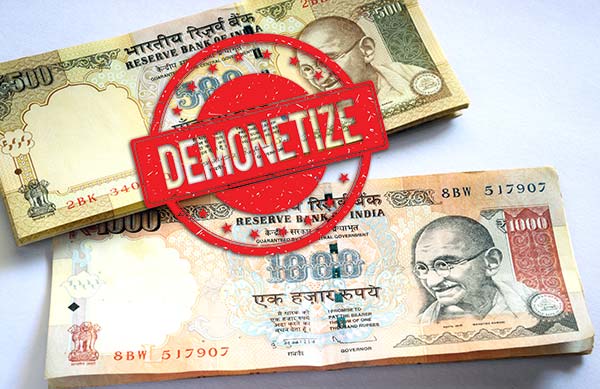By Chandra Mittal, Ph.D. The immediate aftermath of demonetization of Rupee 500 and 1000 Gandhi series notes in India by Prime Minister Narendra Modi’s government on November 8, 2016 created a big bang in the moral enclaves of India, which had been complaining about widespread corruption and scandals under the previous Congress rule for decades. Since India has about 86% of its currency in circulation to fuel its “cash-centric” economy, Modi and company considered change of currency to be the most effective way to root-out corruption from Indian society. A radical step many will never dare take in a country as large, historic, traditional, diverse, culturally complex, and economically strapped as India. The sole purpose of Prime Minister Modi to implement demonetization was to unearth the unaccounted money that has been fueling India's underground economy for decades. Although nobody knows the exact size of this economy, it has been estimated to be almost as big as the official Gross Domestic Product (GDP). Furthermore, this number two economy has been closely integrated into the declared official economy, which presents its own challenges. The demonetization project is intended to cleanse the Indian economy of underground stream and modernize it, and integrate it into the world economies. Today, however, after 8 months since the demonetization big bang, its political echo seems to be rapidly subsiding, and is being replaced by voices of discontent among the Indian middle- and lower-class. This hardest hit by the demonetization is the lower socio-economic group of India due to lack of employment opportunities. On the ground level, while the public response is mixed depending on the socio-economic status of the people, one reaction is common among all that in the near-term demonetization is hurting just about everybody, albeit for different reasons. Demonetization has indeed served as a double whammy. It has reduced business investments in small businesses that create most employment, as well as cut into consumption of goods. While the long-term impact of demonetization may be positive for India, in the near-term Indian economy is projected to grow in 5-6 percent range. And if one factors in the inflation, growth would be anemic affecting the weak segment to significant extent. Such statistics are also confirmed by national and international economic agencies. Another major front where demonetization is not doing its magic is the generation of the unaccounted (black) money through bribery and tax evasion by businesses. Socially and culturally it is a sensitive issue but at individual level bribes are the prime source of black (unaccounted) money, which then finds its way into real estate transactions, weddings, jewelry, etc. The tax-evaded monies, on the other hand, generally fund political activity in India. The recent passage and implementation of Goods and Services Tax (GST) in India is supposed to bypass multiple points of tax collection, and boost tax revenues to the public exchequer. Its ultimate intended impact is, however, yet to be realized at the national level. While the negative impact of corruption and black money on a nation’s economy is well known, it is not easy to stop these with stroke of a pen without serious adverse economic and political consequence. Historically, black or unaccounted money has been around in India for almost as long as the country itself. Culturally, it is accepted by the society, and is tolerated by the establishment in the larger social and political interest. After the independence of India in 1947, reportedly one left-leaning senior politicians from West Bengal urged Prime Minister Jawaharlal Nehru to rein in on the black money in India. But Nehru, a history scholar and an astute politician, declined to do so citing that it was better for the black money to be invested in the economy to grow it. Nehru clearly knew the political compulsions of India as a developing country. His priority was economic growth to meet country’s near-term demands rather than be an idealist. In the modern times, however, given the nature of Indian economy, both in size and scope, it has to become more open and integrate into the world economy. So, it requires a pivot in the international direction by becoming more transparent and accountable to the world. As an aspiring industrial economy India has to play by the global rules. It is perhaps this compulsion and necessity that has driven Narendra Modi to undertake the demonetization step. But given the fragmented nature of India economy, diverse social structures, and poverty, such reform is a major balancing act involving political risks. In order to forge ahead with modernization of Indian economy, integrate it into world economy, and be transparent, Prime Minister Modi will have to curb bribery culture at all levels including in the political sphere. This could be, however, politically hazardous for him. But, unless and until, he can accomplish these, chances of India joining the ranks of global modern economy will remain elusive, and it will linger on as a struggling developing country despite its promise to the contrary. (Dr. Chandra Mittal is Professor at Houston Community College and Co-Founder of Indo-American Association (IAA). Contact: drckmittal@yahoo.com: Twitter: @drchandramittal).
Demonetization in India: An economic reform with cultural dilemma
- by Rinku
- August 02, 2017 2 minutes

demonetise











